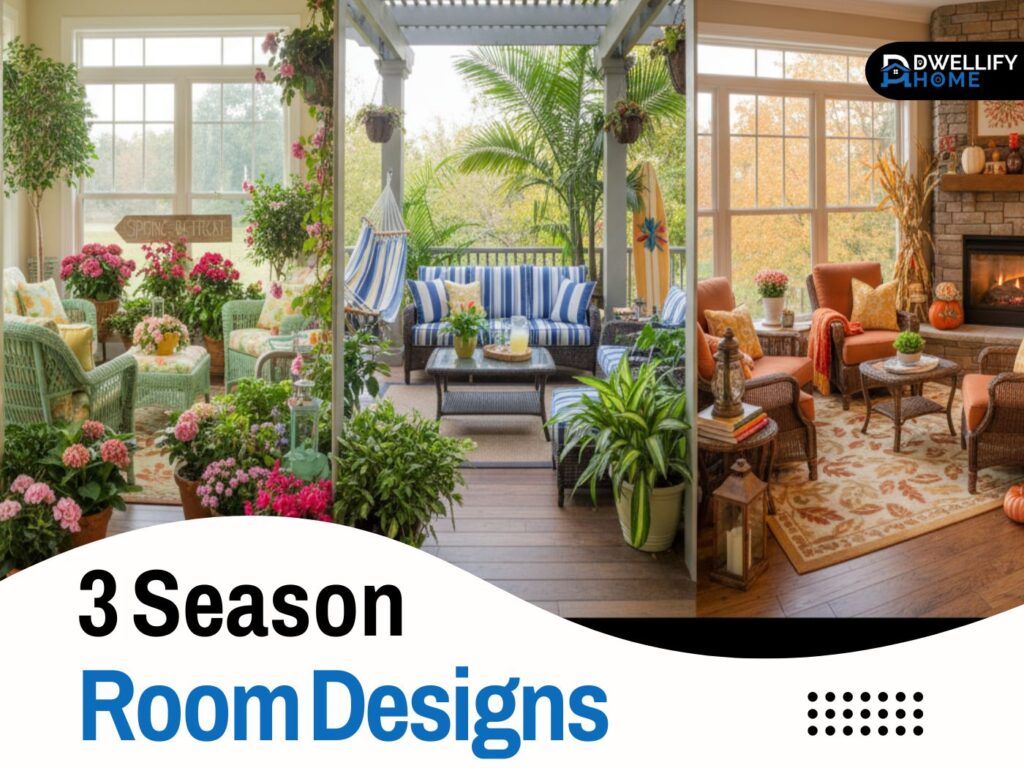Imagine sipping your morning coffee surrounded by the warmth of sunlight and the beauty of your backyard, without the bugs or harsh weather ruining the mood. That’s exactly what a 3 season room offers. It’s that sweet spot between indoor comfort and the joy of the outdoors. Most homeowners build one to enjoy spring, summer, and fall — when the weather is friendly enough to relax without needing full heating or cooling.
Here’s the thing: planning a 3 season room is not just about glass and screens; it’s about creating a space that feels like an escape right at home. In this guide, we’ll explore beautiful design ideas, real cost insights, and expert tips to make your own 3 season room both practical and stunning.
Snippet‑Ready Definition:
3 season room designs feature enclosed porches or sunrooms built for spring, summer, and fall enjoyment. They blend indoor comfort with outdoor beauty using glass, screens, and seasonal décor.
Mission Statement:
Our mission is to empower homeowners with creative, reliable, and experience‑tested guidance for designing functional, stylish, and budget‑friendly 3 season rooms that celebrate the connection between indoor comfort and outdoor living.
What Is a 3‑Season Room and Why It’s Worth Building
A 3 season room is basically an enclosed porch or sunroom designed for use during most of the year — except the coldest winter days in some areas. It’s different from a 4 season room because it isn’t typically insulated for extreme temperatures, but it still gives you protection from wind, rain, and insects.
So why do homeowners love it so much? Because it offers balance. You get fresh air and outdoor light without dealing with mosquitoes or chilly winds. On top of that, it adds real value to your home by creating flexible living space — think of it as an affordable luxury room that extends your lifestyle outdoors.
If you live somewhere with mild springs and falls, you’ll use it almost year‑round. Even in colder climates, you can make it cozy with portable heaters or layered fabrics.
Essential Design Elements for Every 3 Season Room
Creating a comfortable and stylish 3 season room starts with a smart design plan.
Windows and Glass
The windows are the star of the show. Choose large panels to capture natural light. Tempered glass offers strength, while Low‑E coatings help control UV rays and glare. Many modern 3 season room designs use double‑pane glass for better insulation and noise reduction.
Flooring Options
Your floors must handle moisture and temperature swings. Porcelain tile, luxury vinyl, and treated hardwood are popular picks. If your home has a rustic feel, composite decking can add charm that blends with the outdoors.
Roof Styles and Lighting
Roofs can change the mood entirely. A simple shed roof feels modern and elegant, while a gable or cathedral style adds spaciousness. Maximize light with skylights or roof windows. Ceiling fans help with ventilation, while layered lighting — wall sconces, string lights, and floor lamps — keeps it cozy after sunset.
Popular 3 Season Room Styles and Design Inspirations
Modern 3 Season Room Designs
Sleek frames, dark trim, clear lines — that’s what modern sunrooms are all about. Go for minimalist furniture and neutral colors. Add sliding or folding glass doors that open your living area to a deck or patio. It gives your home a seamless, airy vibe.
Rustic and Farmhouse
If you prefer warmth and comfort, farmhouse 3 season rooms are timeless. Think white shiplap walls, wicker chairs, and potted plants. A simple jute rug and string lighting can make it feel like an evening retreat in the countryside.
Simple and Small Designs
Don’t have a big budget or large backyard? No problem. Even small 3 season rooms can feel luxurious with smart layout planning. Use multi‑functional furniture like storage benches, folding tables, and wall‑mounted shelves. Light colors and mirrors make compact spaces feel open and bright.
Transitional Style
Love both modern and classic looks? Transitional styles combine sleek materials with warm finishes — like black windows against natural wood floors. It’s a balanced look that fits most homes.
Converting Your Deck: Building a 3 Season Porch on an Existing Deck
If you already have a deck, you’re halfway there. Many homeowners transform an existing deck into a 3 season room. Before you start, check if your deck’s foundation can support the new structure. A contractor can help assess the load capacity and local building code requirements.
Use aluminum or treated wood framing for strength, and design window walls that align with your home’s proportions. Visually, it should look like part of your home, not an afterthought. Add matching trim or siding so the new enclosure feels like it’s always been there.
3 Season Room Designs on a Budget
You don’t need a huge budget to get a beautiful space. The key is smart material choices. Aluminum framing is sturdy yet affordable, and vinyl windows can mimic pricier wood finishes.
Some homeowners choose to DIY portions of the project, like interior painting or décor. Just ensure structural elements, electrical work, and roofing are handled by professionals for safety.
Budget tips:
- Reuse your outdoor furniture, repaint or refinish instead of buying new.
- Install pre‑made screen or window panels to save on custom costs.
- Focus spending on insulation and flooring — two features that influence comfort most.
Guess what? A thoughtfully planned budget 3 season room often looks just as inviting as a high‑end one because creativity beats cost every time.
Visual Inspiration and Layout Ideas
Even if you haven’t designed one before, studying pictures of 3 season rooms will spark ideas. You’ll notice certain constants — large windows, simple furniture, and light color palettes.
Arrange furniture so that people naturally face outdoor views. Keep pathways clear. Want a cozy reading area? Set up a small loveseat under a window and add a throw blanket. Want to entertain guests? Try an L‑shaped seating arrangement with nesting tables.
If your space is narrow, use tall planters or vertical décor to draw the eye upward. The goal is to create flow while keeping it uncluttered.
Understanding 3‑Season Room Costs
Let’s talk money because budgets matter. Costs vary by region, but the average 3 season room runs between $100 and $300 per square foot. The range depends on choices like:
- Framing material (wood vs aluminum)
- Glass type and roof design
- Whether you DIY or hire professionals
DIY builds can be 30% cheaper but often require more time and problem‑solving. Hidden costs such as permits, electrical wiring, or flooring upgrades can add up — so plan for an extra 10–15% cushion in your budget. Think long‑term too: energy‑efficient windows may cost more upfront but save heating and cooling costs down the road.
Expert Tips to Maximize Comfort and Longevity
After years of helping families design enclosed porches, I’ve learned a few rules that apply everywhere.
- Prioritize airflow: ceiling fans and operable windows prevent stuffiness.
- Seal joints properly: moisture can shorten the life of framing if ignored.
- Use weather‑resistant finishes: UV‑blocking sealants or fade‑resistant fabrics.
Want to make it usable even on cooler days? Add thermal curtains or portable infrared heaters. For sunny climates, consider retractable blinds that reduce glare without blocking the view.
Maintenance counts too: clean the windows twice a year, check for cracked caulking, and reseal floors every few years. With a little attention, your 3 season room can easily last decades.
Uncommon and Expert‑Level Ideas You Might Not Have Considered
Here’s where design gets fun. A few creative touches can transform a good room into a wow room.
- Biophilic design: Add greenery. Built‑in planter boxes along window bases look beautiful and improve air quality.
- Sliding or folding glass walls: These open the entire space to your yard when weather’s perfect.
- Smart features: Automated shades, energy‑saving lights, and even wireless speakers make the room feel futuristic.
- Eco‑friendly surfaces: Bamboo floors and recycled glass décor pieces are stylish and sustainable.
These small but clever upgrades show care, creativity, and forward thinking — qualities Google’s Helpful Content guidelines love because they genuinely add value for homeowners.
Extending Comfort Beyond the Three Seasons
Many people ask, “Can I use my 3 season room in winter?” The answer is mostly yes — if you prepare smartly. Adding removable insulation panels or heavy‑duty curtains helps trap heat. Portable space heaters or radiant floor mats keep it cozy.
If you don’t want to convert fully to a 4 season room, consider translucent vinyl panels for the colder months. They’re affordable and easy to install, yet effective at blocking drafts.
Lighting Ideas for Cozy Evenings
Lighting often gets overlooked, but it shapes mood more than décor. Combine ambient ceiling lights with accent lights such as wall sconces or table lamps. If you love lazy evening chats, string fairy lights across the ceiling beams for a warm glow.
Dimmer switches are lifesavers — bright enough for reading, soft enough for relaxing. Modern solar‑powered lanterns add charm without increasing your electricity bill.
Common Mistakes to Avoid
Designing a 3 season room is exciting, but there are a few traps to dodge.
- Skipping proper ventilation: leads to mold and musty smells.
- Using indoor furniture outdoors: regular fabrics fade or warp with humidity.
- Ignoring building codes: you might have to redo parts of the project.
- Over‑decorating: too many colors or bulky pieces kill the open feeling.
Staying practical keeps both your wallet and your design safe.
Integrating Nature and Greenery
A 3 season room is meant to celebrate the outdoors, so bring a little greenery inside. Cluster potted herbs near windows or hang succulents along the frame. They thrive on sunlight and bring freshness to the air.
Choose lightweight pots in natural clay or woven rattan for that seamless indoor‑outdoor look. Even if you’re in the city, a few planters filled with lavender or rosemary instantly create calm.
Energy‑Efficient and Sustainable Additions
Sustainability isn’t just a buzzword. Little changes can make a big difference. Choose LED bulbs for all lighting, and Low‑E or double‑pane windows to reduce heat loss. Solar‑powered ceiling fans or vents are eco‑friendly options that actually work.
Flooring made with recycled materials — like bamboo or vinyl composite tile — is a great way to reduce impact without sacrificing style. Making energy‑smart choices means your 3 season room will stay comfortable with less energy use year after year.
How to Capture Great Pictures of Your 3 Season Room
Once you’ve built it, take time to capture your new haven. Photograph during daytime when the room is filled with natural light. Shoot from angles that show the connection between indoors and outdoors.
If you plan to sell your home, these pictures highlight added value. For personal use, they’re perfect for tracking décor upgrades and seasonal styling.
Comparison Table – 3 Season Room vs 4 Season Room
| Feature | 3 Season Room | 4 Season Room |
| Use Period | Spring–Fall | Year‑round |
| Insulation | Minimal to moderate | Fully insulated |
| Heating/Cooling | Optional portable units | Integrated HVAC |
| Cost Range | $$ (affordable) | $$$$ (higher investment) |
| Comfort Level | Excellent for mild climates | Great for all climates |
| Purpose | Relaxation, dining, entertaining | Permanent living space |
Step‑by‑Step Guide: Planning Your 3 Season Room
- Assess Your Space: Measure existing porch or deck area; check structure and slope.
- Set a Budget: Include permits, framing, windows, flooring, and décor.
- Choose a Style: Modern, rustic, or transitional based on your home’s architecture.
- Select Key Materials: Weather‑resistant framing, Low‑E glass, durable floors.
- Plan Ventilation & Lighting: Add ceiling fans, skylights, layered lighting.
- Add Personal Touches: Furniture, greenery, cozy textiles, and DIY accents.
- Schedule Maintenance: Clean glass, reseal joints, and refresh décor seasonally.
Conclusion: Your Perfect 3 Season Room Awaits
A 3 season room is more than an addition — it’s a lifestyle upgrade. It lets you enjoy the sounds of rain, the warmth of fall sun, and the scent of fresh spring air without stepping outside. Whether you go modern, rustic, or budget‑friendly, you can create a relaxing retreat that feels completely yours.
The best part? Every single 3 season room tells its owner’s story — one of comfort, creativity, and connection to the outdoors. If you’ve been dreaming about adding one, start planning. Your future self, sitting in that comfy chair surrounded by sunlight, will thank you.
Frequently Asked Questions
What exactly is a 3 season room?
It’s an enclosed porch or sunroom designed mainly for spring, summer, and fall. It protects from rain and insects but usually isn’t heated for winter.
How much does a 3 season room cost?
Costs vary from about 10,000 to 10,000 to 40,000depending on size, materials, and labor. Adding insulation or premium glass increases the price.
Can I build a 3 season room on my existing deck?
Yes! If the deck’s structure is solid and meets code, it can be enclosed with walls and windows. Always verify local permit requirements first.
What’s the difference between a sunroom and a 3 season porch?
A sunroom may include heating and full insulation for four seasons, while a 3 season porch focuses on natural airflow and cost‑effective design for fair‑weather use.
How can I warm my 3 season room in cooler months?
Use electric space heaters, insulated curtains, or temporary vinyl panels. These quick fixes extend comfort without a full conversion to a 4 season room.
Disclaimer
This article provides general design and home‑improvement information for educational purposes. Always consult certified contractors, local building authorities, and safety professionals before beginning structural or electrical work on your property.

I’m Bilal, the founder of Dwellify Home. With 6 years of practical experience in home remodeling, interior design, and décor consulting, I help people transform their spaces with simple, effective, and affordable ideas. I specialize in offering real-world tips, step-by-step guides, and product recommendations that make home improvement easier and more enjoyable. My mission is to empower homeowners and renters to create functional, beautiful spaces—one thoughtful update at a time.




